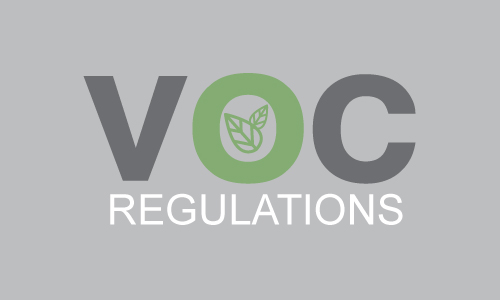Volatile Organic Compounds (VOC) and Hazardous Air Pollutants (HAP) are generated when chemicals vaporize and form a gas. These gases create ground-level pollution, also known as smog. While these compounds are harmful to humans, they are also highly toxic to the environment. Therefore, the Environmental Protection Agency (EPA) regulates the amount of VOCs and HAPs released by manufacturers nationwide.
Furthermore, specific guidelines exist for each type of product used by manufacturers, such as automobile, architectural, and aerosol coatings. As a result, facility owners may be subject to varying limits, both within the production process and for the emissions generated by the plant.
Federal Regulations
The Clean Air Act (1970) oversees emission limits for all stationary and mobile sources. The EPA’s National Volatile Organic Compound Emission Standards are based on the rules outlined in the Clean Air Act and inform industries on VOC limits and production protocols. These regulations were enacted to help reduce VOC emissions by 90,000 tons per year.
To meet these goals, the EPA sets VOC-to-product ratios for applicable industries. For example, pretreatment wash primers used in automobile coatings must contain no more than 780 VOCs per liter of product. The EPA outlines all regulatory limits for each industry and the national VOC limits required during and after the manufacturing process.
In addition to restrictions within the production process, compliance monitoring is conducted under the EPA’s National Emission Standards for Hazardous Air Pollutants (NESHAP) program. Monitoring is required for large stationary sources emitting pollutants that can cause severe health issues and birth defects. Performance tests must be conducted throughout production, and monitoring devices may be required on-site. Facilities subject to these tests are defined as “major sources” and are evaluated every two years.
State-Level Regulations
The Clean Air Act requires local authorities to maintain a set level of air quality and deploy state implementation plans (SIPs) to help meet those standards. Typically, SIPs set stricter emission limits than federally required in an attempt to reach the standards prescribed to that state. Therefore, the location of your plant may affect the limits placed on its emissions.
Manufacturers can meet emission standards by lowering the amount of VOCs used in the production process or installing emission control units designed to destroy harmful pollutants. Depending on your state’s limits, you may be required to employ both methods to meet federal requirements. The EPA outlines all active state implementation plans and provides detailed limits for each industry within that state.
Reasonably Available Control Technology (RACT)
While a further reduction of VOCs and HAPs may be desired, the EPA and governing bodies understand that the technology available must be taken into consideration when setting limits. Therefore, compliance efforts are judged on Reasonably Available Control Technology (RACT).
As new limitations are proposed, the current technologies are assessed and regulations are adjusted accordingly. Therefore, it’s important to review and renew any active emission control systems used on your plant to stay in compliance with the regulations associated with this rule. Updating old units may also lead to lower costs and decreased emissions.
Recent Regulatory Changes
Federal rules and SIPs are regularly updated. Most recently, Maryland and Connecticut lowered emission limits on new and existing industries to meet the standards outlined in the Clean Air Act. In 2017, California updated its SIP to include additional reporting requirements for big-box retailers. These updates are made as the EPA and state governments review emerging technologies and monitor the impact of new manufacturing processes.
Emission limits and regulations are constantly under review. Therefore, it’s vital to not only comply with the requirements outlined by the government but adopt the latest emission control technology to combat the continuous rise in stricter regulations.




